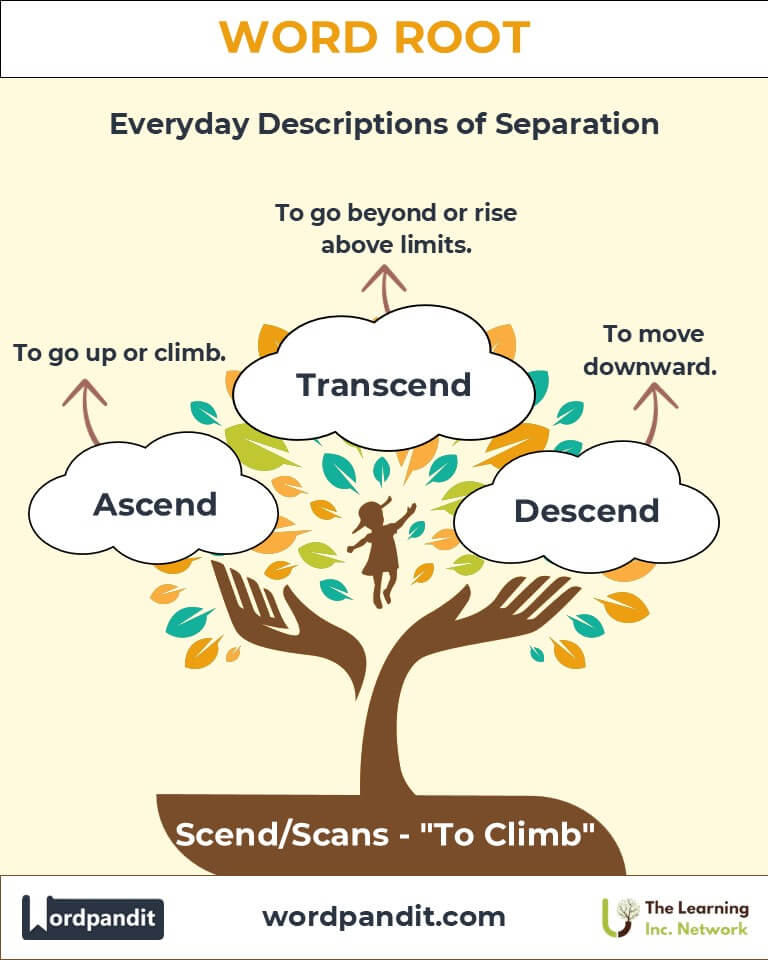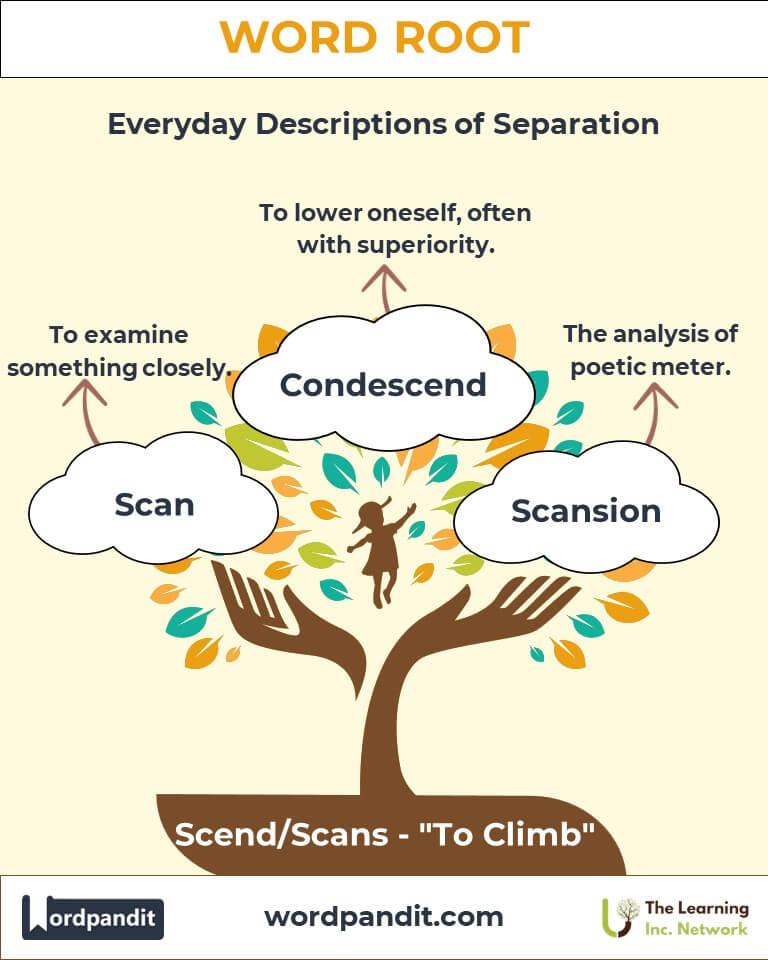Scend and Scans: The Roots of Ascent and Descent in Language and Beyond
Byline: The roots scend and scans, originating from Latin scandere, meaning "to climb," have scaled their way into various facets of language, evoking the imagery of movement, progress, and challenge. From common words like ascend and descend to specialized terms, these roots represent journeys—both literal and metaphorical—up and down life's many peaks and valleys.

Table of Contents
- Introduction: The Essence of Scend and Scans
- Etymology and Historical Journey
- Mnemonic: Unlocking the Power of Scend and Scans
- Common Scend/Scans-Related Terms
- Scend and Scans Through Time
- Scend and Scans in Specialized Fields
- Illustrative Story: Scend and Scans in Action
- Cultural Significance of the Roots
- The Scend and Scans Family Tree
- FAQs About the Scend and Scans Word Root
- Test Your Knowledge: Scend and Scans Word Root Quiz
- Conclusion: The Living Legacy of Scend and Scans
1. Introduction: The Essence of Scend and Scans
Imagine a hiker ascending a steep mountain trail or a skier gracefully descending a snowy slope. These vivid images capture the essence of the roots scend and scans, which denote the act of climbing or moving vertically. Pronounced as skend (scend) and skans (scans), these roots trace their origins to Latin, appearing in everyday and specialized words that describe physical motion and figurative progress.

2. Etymology and Historical Journey
The roots scend and scans stem from the Latin verb scandere, meaning "to climb." In ancient Rome, scandere described scaling literal heights—walls, ladders, and mountains. Over time, these roots were absorbed into Middle English through Old French, evolving to represent not just physical climbing but also conceptual ascents and descents, like climbing the social ladder or descending into despair.
3. Mnemonic: Unlocking the Power of Scend and Scans
To remember scend and scans, visualize a seesaw in motion. As one side ascends, the other descends, perfectly illustrating the dual nature of these roots.
Mnemonic Device: "Scend climbs high, while scans glides low, the roots of up and down we know."
4. Common Scend/Scans-Related Terms
- Ascend (uh-send): To go up or climb.
Example: "The balloon ascended into the clear blue sky." - Descend (dih-send): To move downward.
Example: "The hikers descended the mountain before nightfall." - Transcend (tran-send): To go beyond or rise above limits.
Example: "Her performance transcended expectations." - Condescend (kon-duh-send): To lower oneself to do something, often with a sense of superiority.
Example: "He condescended to explain the concept to the novices." - Scan (skan): To examine something closely (a figurative extension of climbing over or across).
Example: "She scanned the document for errors." - Scansion (skan-shun): The act of analyzing verse to show its meter.
Example: "The poet performed a careful scansion of the sonnet."
5. Scend and Scans Through Time
- Ascendancy (Historical): Originating in the 17th century, this term evolved to describe dominance or a rise to power.
Example: "The ascendancy of the Roman Empire reshaped Europe." - Descension (Archaic): Once widely used, it referred to a decline or downward movement, now largely replaced by "descent."
- Transcendental (Modern): Rooted in philosophy, it reflects concepts that go beyond empirical experience, popularized by thinkers like Kant and Emerson.
6. Scend and Scans in Specialized Fields
- Geography:
- Ascend: Climbing terrains or elevations.
- Descend: Geological features like canyons and valleys.
- Literature: Scansion: Analyzing poetic meter to uncover rhythm and structure.
- Philosophy: Transcend: Exploring metaphysical ideas beyond physical reality.
- Technology: Scan: Used in digital contexts, such as scanning documents or barcodes.
7. Illustrative Story: Scend and Scans in Action
Lila, an avid rock climber, faced her greatest challenge: ascending the sheer face of El Capitan. As she climbed, she recalled her professor’s lecture on poetry, where scansion brought rhythm and clarity to chaotic verse. In a moment of reflection, she realized her ascent was like a poem—structured yet challenging, requiring both physical strength and mental resolve. At the summit, her triumph mirrored the transcendence she felt, blending the literal and metaphorical power of scend and scans.
8. Cultural Significance of the Roots
The imagery of climbing and descending permeates global cultures. From the spiritual ascent of enlightenment in Buddhism to Dante’s descent into hell in the Divine Comedy, these roots symbolize profound journeys. Their duality reflects life’s cyclical nature: for every rise, there is a fall.

9. The Scend and Scans Family Tree
- Grad- (Latin, “step”):
- Graduate: To step up in academic achievement.
- Degrade: To step down in quality or respect.
- Cline- (Latin, “lean”):
- Incline: To lean or slope upward.
- Decline: To slope downward or deteriorate.
- Mot- (Latin, “move”):
- Motion: The act of moving.
- Promote: To move forward or advance.

10. FAQs About " Scend” and “Scans"
Q: What do the roots scend and scans mean?
A: The roots scend and scans originate from the Latin word scandere, which means "to climb." These roots describe upward and downward movements, not just physically but also metaphorically, as in climbing the ranks or descending into chaos.
Q: How are ascend and descend different?
A: Ascend means to go up or climb to a higher position, whether physically (e.g., climbing a mountain) or metaphorically (e.g., ascending to power). Descend refers to moving down from a higher position, either literally (e.g., descending stairs) or figuratively (e.g., descending into despair or conflict).
Q: Why does scan mean to examine closely?
A: In its original sense, scan involved sweeping over or climbing across a surface to examine it. This evolved into its modern usage of carefully analyzing or inspecting something, much like climbing step by step to explore a higher view.
Q: What does transcend mean? How does it relate to climbing?
A: Transcend combines the prefix trans- (across) with scend, meaning "to climb." It signifies surpassing limits or boundaries, much like climbing beyond a peak or obstacle to reach new heights, whether in thought, achievement, or experience.
Q: What is scansion, and why is it important in poetry?
A: Scansion is the analysis of a poem’s meter, rhythm, and structure. It breaks down verses into stressed and unstressed syllables to uncover the poem’s musicality and deeper meaning. This detailed examination allows readers to appreciate the craft behind the poem.
Q: What is the etymology of condescend?
A: Condescend combines con- (together) with descend (to go down). Originally, it meant willingly lowering oneself to connect with others. Over time, it acquired a negative connotation of acting superior while pretending to lower oneself.
11. Test Your Knowledge: “Scend” and “Scans” Mastery Quiz
1. What does the root scend signify?
2. Which term describes the analysis of poetic rhythm?
3. What does descend signify?
4. Which word relates to exceeding limits or boundaries?
5. What is the origin of the roots scend and scans?
12. Conclusion: The Living Legacy of Scend and Scans
The roots scend and scans climb through our language, embodying notions of challenge, growth, and exploration. From ascending the peaks of ambition to scanning the depths of literature, these roots inspire us to embrace both the heights and depths of life’s journey. Let their enduring legacy motivate your ascent toward knowledge and self-discovery.












